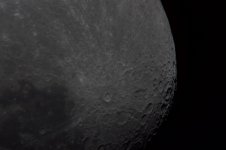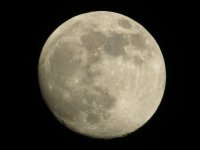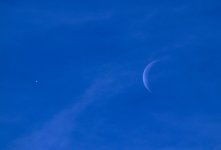Saturn is about 10 AU from the Sun so it should vary from about 9-11 AU from Earth.
Wikipedia says the angular size of the disk will range from about 15-20 arcseconds, with the rings being almost double that across - actually wider than Jupiter’s disk.
Well, with 1" lens of typical long zoom camera I expect Saturn to be 2 pixels wide and rings twice of that. Just wonder if it can really be resolved as something other than a point object.
This is a photo I took of Jupiter with the same camera I used for the moon above. Jupiter is definitely not a point object. If Saturn's rings are at an angle, I'm pretty sure that the camera would be able to show that the rings exist but as I mentioned, probably no colors. The camera is one of those superzooms. It has a small point and shoot sensor but a very long zoom. In the case of this photo, 204 mm. The camera can zoom farther. I expect that when I took this in 2012 that I backed off the zoom to get the moons in.
I don't recall how much care I took taking this or if the camera was in single shot mode or night shot which takes multiple shots and stacks them. The camera could probably do a bit better if I didn't take this hand held which I believe that I did.
View attachment 33857




